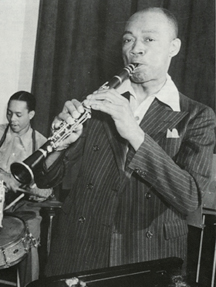Like 1938, the year of Benny Goodman's Carnegie Hall triumph and Artie Shaw's ascendancy to national prominence, the year 1954 is a major benchmark for jazz clarinet. Shaw's massive final recordings project took place during the first half of that year, ultimately overshadowing all other performances. But tucked away in that history, on August 7th and 14th, recordings were made of broadcasts from Club Hangover in San Francisco of the Ralph Sutton Quintet, with Edmond Hall on clarinet.
The recordings aren't ideal--neither the microphone placements nor the acoustics of the club are particularly inspiring, especially when compared to some of the great live jazz recordings from that era in venues such as the Village Vanguard or the Blue Note. But they are clean, and obviously of equal or better quality as the earlier swing era live checks from the Madhattan Room and elsewhere.
Considering those Edmond Hall served with as a sideman (he was Louis Armstrong's go-to clarinetist for years) and the pianists he'd recorded with (Teddy Wilson and Eddie Heywood among others), this group is much more humble. Ralph Sutton was a solid jazz pianist of the old stride school, and Clyde Hurley a very good trumpet man--all the players on these dates were the "real deal" among musicians--but it would have been impossible for even excellent players to rival the legends on Hall's resume.
Having said this, jazz is not like classical music. The best recordings are not invariably done by the top technical players, and the music, being an exercise in active, communal creativity rather than primarily concerned with reproducing someone else's musical thought, cannot always be well judged by personnel. Armstrong himself often worked with inferior sidemen, as did Sidney Bechet. Shaw and Goodman's recordings are filled with performances by sidemen who never sounded as good afterwards--they were often lifted to greatness by those around them. Duke Ellington's band, despite having brilliant players like Johnny Hodges, Ben Webster, and many others, was always more than the sum of it's parts technically.
Like great basketball players, jazz musicians are often best judged by how they improve the players around them. That this recording provides such a good example makes it indispensable. In many ways, it strikes the listener as an average professional jazz gig from 1954--and therefore a valuable contrast to the pellucid masterpieces of the Shaw Gramercy 5 recorded only months earlier. The gigs contain a laundry list of war horses still on bandstands today: 'St Louis Blues', ' I Got Rhythm', 'Honeysuckle Rose', 'Between the Devil and the Deep Blue Sea', and more. The style is a loose, natural fusion of swing, New Orleans, and boogie woogie--a type of lingua franca, catch all "jazz" style for that era (soon, this style would be considered 'traditional', as bop and other aspects of modern jazz entered the mainstream). Edmond Hall is such a powerful presence on these numbers that he seems the musical leader of the group, though because of his firm New Orleans roots, is so committed to ensemble that he stays within the groups parameters, lifting the level of inspired play for all. Clyde Hurley's trumpet solo on 'Black and Blue', for instance, delivers such powerful soul tonally, that the listener doesn't care who is playing or where: we're just grateful.
Edmond's sound is not well captured here. There are many potential reasons for this, ranging from poor microphone placement to a bad reed. But it doesn't matter. In fact, it's probably better that he doesn't sound anywhere near his best self on this recording: we get to hear what a musician like Hall can accomplish in less than perfect conditions.
This recording is one of my personal favorites. The sound isn't great, but in some ways it's more honest than studio recordings are--and getting to that level of reality can become addictive in it's own way. In fact, it was because of recordings like this that I decided to release our 'Bootlegs from the Bop Stop' CD last year, so you could say that this album had a permanent impact not only on my playing, but my conception of what makes a great album.
 |
| Edmond Hall Image Courtesy Wikimedia Commons |
